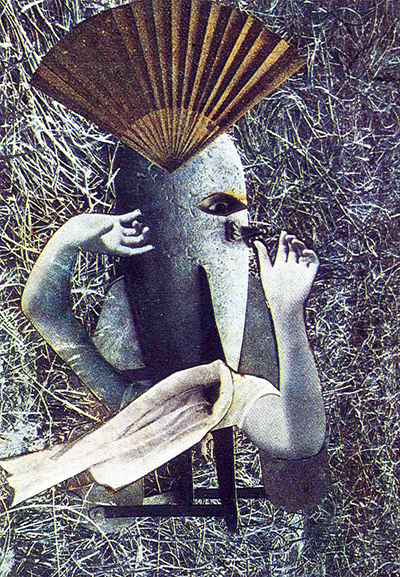The Chinese Nightingale was created in 1920 by Max Ernst and is another example of the Dadaism school of art initiated by a number of European avant-garde artists in the early twentieth century which was particularly prevalent in Germany, Switzerland and France.
The Dada movement blurred the line between visual and literary arts and the artist was also a poet and sculptor. In addition to the Chinese Nightingale the artist made a series of similar works between 1919 and 1920 that combined weaponry with human limbs. This represented a deep-seated fear of the machinery of war which was probably enhanced by a gun injury suffered by Ernst.
The Dadaists used a technique called photomontage which is evident in the Chinese Nightingale and this consisted of a montage of photographic images. In this particular piece of artwork Ernst has continued his phase of combining human limbs with war machinery, or other accessories, to create disturbing hybrid creatures. Many Dadaists used art as a political message, however, Ernst uses a slightly more poetic style than some of his contemporaries and adopts more subdued elements to diffuse the horror of the weaponry. The collage features the limbs and fan of an oriental dancer, with the latter acting as a headdress. However, the body is an English bomb with the addition of an eye to give the impression of a strange birdlike creature, and this somehow serves to lessen the impact of the grotesque machinery.
Ernst had an deep and abiding interest in psychoanalysis, particularly Freudian, and this is evident in much of his work which often has sinister and nightmarish undertones and makes references to various anxieties. His artwork may combine his artistic expression with his fear of weaponry as he sustained an war injury when a gun recoiled. Thus, in a series of similar artworks Ernst appears to express the anxiety he feels by depicting the weaponry, then uses surreal techniques to dampen the effect and reduce the fearful qualities of the machinery.
The artwork unearths a series of emotions in the viewer, as the machinery seems frightening on one level but is somehow made to look silly or bizarre by the addition of the more abstract elements that puzzle and intrigue. As with other artists of this movement Ernst creates pictures that provoke the imagination and stay in the mind long after they have been seen.




